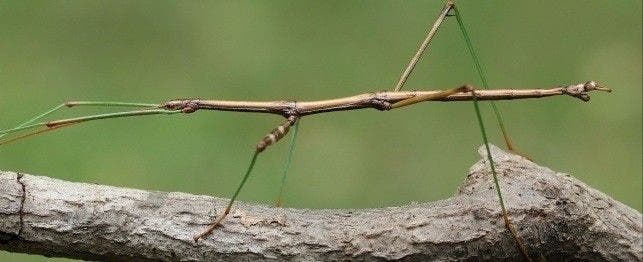
Choosing a Stick Insect
As an alternative to the usual turtle or hamster, you might want to consider getting your child a walking stick, one of the most popular insects to keep as a pet. They can hide in plain sight with camouflage that is so perfect they are nearly indistinguishable from the branches of the plants on which they feed. Blow on them and they will even sway back and forth on their long legs to mimic the movement of a twig in a breeze.
There are almost 3,000 species of stick insects (or phasmids) worldwide. Perhaps the easiest to care for are called Indian, or laboratory, stick insects, Carausius morosus. They have the habit of folding their legs in when held to complete their stick disguise.
Although most species are long and slender, some of the more spectacular varieties have flattened bodies and disguise themselves as leaves. One of the most impressive of these is the Australian spiny leaf, Extatosoma tiaratum, which can grow to resemble an 8-inch-long spiny branch with dead leaves for legs.
Housing Your Stick
A standard 10-gallon terrarium will make a fine home for your insects, but regardless of the container you use it should be tall enough to allow them to hang from twigs and leaves, especially when they are molting. The enclosure should also allow easy access so you can replace the plant material and keep it clean. Some species, such as the Indian stick insect, can survive almost anywhere on a variety of leaves, making them potential pests, so a secure lid with a fine mesh screen is important to prevent escapes.
Some species need more humidity than others, and it is a good idea to lightly mist the leaves in the tank to give them a source of water.
Allow bottled water or tap water to sit out for a day or two to dechlorinate before using. Don’t overwater to the point where moisture collects in the tank. Temperatures between 75 and 80 degrees are ideal for most species. For the colder months, you might want to get a special heating pad from a pet store to place under the terrarium to provide extra warmth.
Diet
Stick insects are vegetarians and will do fine on a regular supply of leaves. You can keep the leaves fresh longer by placing their stems in water, but be careful because stick insects can drown in open containers. It is a good idea to keep the water in a closed container, such as a yogurt cup, and to insert the stems in water through a small x-cut in the lid. Almost all species will eat the leaves of blackberry plants and their relatives. Certain oak and Ficus benjamina leaves work for some, as do ivy leaves. You can even experiment with green leaves from the grocery store, like Italian parsley. They prefer mature, dark green leaves over the delicate new growth which can contain natural poisons. Make sure the leaves are clean and pesticide free.
Handling
You or your child may pick up the stick insects and watch them crawl about. The major concern is that the animals may injure their delicate legs. They can hold onto things with a pretty good grip, and some would prefer to lose a leg than let go. Some of the large spiny varieties can also pinch with their thorny legs or bite. One, the American walking stick, Anisomorpia bupestroides, should be avoided. This insect, which has two stripes on its back, can spray an acidic compound that has been reported to cause temporary blindness.
Breeding
When it comes to reproducing, certain species of stick insects have a truly remarkable ability called parthenogenesis, where the females can lay viable eggs without mating with a male. Remove the eggs (which resemble small plant seeds) when you clean the cage and keep them in a small container, with just a bit of damp peat. After several months the tiny sticks will begin to emerge. Without some moisture, they may have trouble freeing themselves from the eggs.